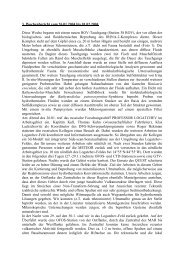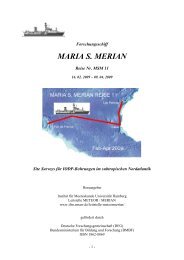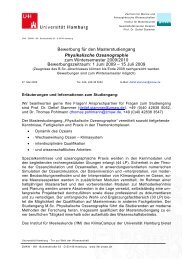MSM01_Expeditionsheft.pdf - Institute of Oceanography, University ...
MSM01_Expeditionsheft.pdf - Institute of Oceanography, University ...
MSM01_Expeditionsheft.pdf - Institute of Oceanography, University ...
Sie wollen auch ein ePaper? Erhöhen Sie die Reichweite Ihrer Titel.
YUMPU macht aus Druck-PDFs automatisch weboptimierte ePaper, die Google liebt.
urg-Vulkan auf 1 bis 11 Volumenprozent,<br />
d.h. 4% bis 19% des Porenvolumens. Die<br />
Chloridionen Konzentration der Porenwässer<br />
aus dem Schlammvulkan sind der des<br />
umgebenden Meerwassers sehr ähnlich, aber<br />
die Isotopenzusammensetzung ist unterschiedlich.<br />
Das Porenwasser weist sehr<br />
schwere Sauerst<strong>of</strong>fisotopenverhältnisse (-<br />
35‰) und leichte Wasserst<strong>of</strong>f-Verhältnisse<br />
(-70‰) auf. Diese Befunde werden als ein<br />
Ergebnis von Vermischungsprozessen interpretiert,<br />
wobei Porenwasser tiefgründige<br />
Fluide aus dem Schlotkanal des Schlammvulkans<br />
beigemengt werden.<br />
Konische Schlammvulkane sind typische<br />
morphologische Strukturen, die in diesem<br />
Gebiet an Fluidaustritte gekoppelt sind. Ihre<br />
Durchmesser reichen von nur einigen Zehnermetern<br />
bis zu 4 Kilometern, und sie können<br />
eine Höhe von 200 m über dem umgebenden<br />
Meeresboden erreichen. Einige Sedimentkerne,<br />
die von diesen Strukturen genommen<br />
wurden (z.B. vom Bonjardim-<br />
Vulkan), wiesen einen starken H2S Geruch<br />
auf. Diese Schwefelwasserst<strong>of</strong>f-<br />
Anreicherung, das Fehlen einer pelagischen<br />
Sedimentbedeckung, und das Vorkommen<br />
zahlreicher Pogonophoren auf dem Top der<br />
Sedimentkerne zeigen aktive Fluidaustritte<br />
an. Einige Schlammvulkane zeigten auch<br />
Hinweise auf multiple Ausflüsse.<br />
Karbonatkrusten und Tiefwasser-Korallen-<br />
gemeinschaften wurden nur im östlichen<br />
Golf von Cadiz, in der spanischen und marokkanischen<br />
Wirtschaftszone, festgestellt.<br />
Jüngste OFOS-Beobachtungen zeigten eine<br />
erstaunlich hohe Dichte von röhrenförmigen<br />
Karbonat-Schloten. Sie werden bis zu 2 m<br />
lang. Einige liegen auf dem Meeresboden,<br />
andere ragen aus dem Weichsediment heraus.<br />
Klüfte und eine Aneinanderreihung<br />
einzelner, isolierter Schlote wurden ebenfalls<br />
beobachtet. Diese Befunde weisen auf<br />
eine störungskontrollierte Verteilung hin.<br />
Die Schlote zeigen eine große morphologische<br />
Vielfalt. Es gibt spiralförmige, zylindrische,<br />
konische, pils- und hügelförmige<br />
Typen mit zahlreichen Knollenfortsätzen<br />
und verästelten Fluidkanälen. Die Schlote<br />
bestehen hauptsächlich aus authigenem Karbonat<br />
(Ankerit) und Fe-Oxiden, die Pseu-<br />
- 24 -<br />
gas hydrate content in the Ginsburg mud<br />
volcano sediments to be 2 – 11% by volume<br />
and 4 -19% by pore space. Chloride ion<br />
concentrations <strong>of</strong> the original mud volcano<br />
water were similar to those <strong>of</strong> the surrounding<br />
seawater, but are isotopically different.<br />
The water is very high in oxygen (to -35‰)<br />
and light in hydrogen (to -70‰) and is interpreted<br />
as a result <strong>of</strong> a mixing process<br />
where pore water is mixed with deep fluids<br />
coming up along the mud volcano feeder<br />
channel.<br />
The typical structures related to fluid venting<br />
in this area are conical mud volcanoes<br />
with diameters ranging from several tens <strong>of</strong><br />
meters to ca. 4 km and heights that can<br />
reach 200 m. In some <strong>of</strong> the cores recovered<br />
from these structures (e.g. Bonjardim mud<br />
volcano), a strong H2S smell is reported.<br />
This, together with the lack <strong>of</strong> a pelagic veneer<br />
and abundant Pogonophora at the very<br />
top <strong>of</strong> the core, appears to indicate active<br />
venting. Evidence <strong>of</strong> multiple flows was also<br />
observed on several mud volcanoes.<br />
Carbonate crusts and cold-water coral<br />
communities were found only in the eastern<br />
sectors <strong>of</strong> the Gulf <strong>of</strong> Cadiz, i.e. the Spanish<br />
and Moroccan sector. Recent observations<br />
from an underwater camera revealed a<br />
spectacular high density <strong>of</strong> pipe-like chimneys,<br />
some <strong>of</strong> them longer than 2 m, lying<br />
over the sea floor, and some protruding<br />
from muddy sediment. Local fissures and<br />
alignment <strong>of</strong> isolated chimneys were also<br />
observed, suggesting that their distribution<br />
is controlled by fault planes. Chimneys collected<br />
show a wide range <strong>of</strong> morphological<br />
types (spiral, cylindrical, conical, mushroom-like<br />
and mounded) with numerous<br />
nodule protuberances and ramified fluid<br />
channel ways. The chimneys are mainly<br />
composed <strong>of</strong> authigenic carbonates<br />
(ankerite, Fe-bearing dolomite and calcite)<br />
with abundance <strong>of</strong> iron oxides, forming ag-


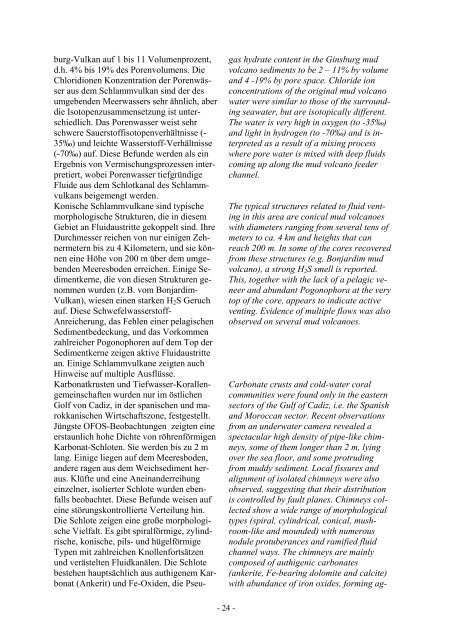
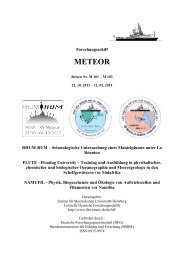

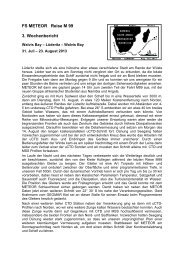
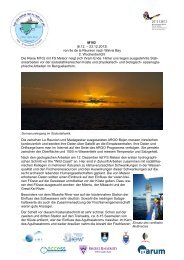
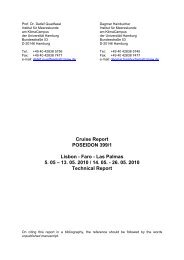
![Expeditionsheft Reisen M99-M100 [pdf] - Institute of Oceanography ...](https://img.yumpu.com/22533092/1/184x260/expeditionsheft-reisen-m99-m100-pdf-institute-of-oceanography-.jpg?quality=85)
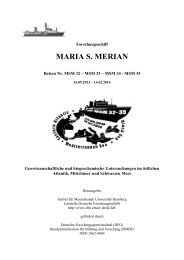
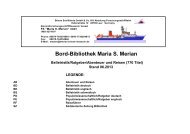
![Darstellungen [pdf]](https://img.yumpu.com/22533086/1/184x260/darstellungen-pdf.jpg?quality=85)



